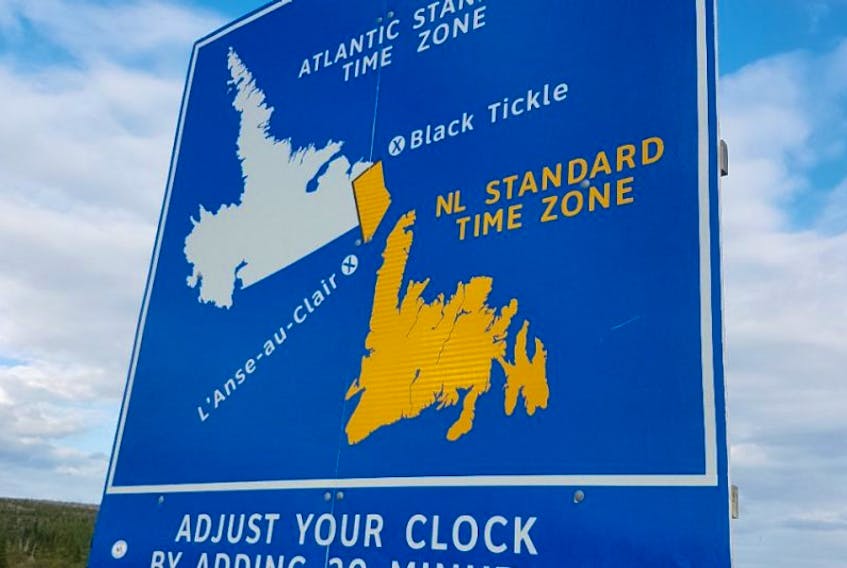In every possible sense, the signs are utterly meaningless.
There is no cell service, no way to connect with the outside world. It’s more than an hour’s drive north to Cartwright, and nearly an hour to Port Hope Simpson to the south, along a dusty gravel road.
Anybody who insisted on changing their clock at that exact spot would need to be a stickler for technicality, but technically, you’d be wrong to change your clock at all.
According to the letter of the law, Labrador shouldn’t have a separate time zone.
All of Labrador should be observing Newfoundland Standard Time, and for the past 82 years, thousands of residents of the Big Land have been flagrantly breaking the law every time they set their clocks.
The Standard Time Act is quite straightforward: “Time in the province shall be reckoned as 3 1/2 hours later than Greenwich mean solar time.”
The Act gives formal, legal effect to the famous little quirk of the province: Newfoundland Standard Time is the only half-hour time zone in the Americas.
The provincial government could recognize Labrador’s traditional observance of Atlantic Standard Time if it wanted to. The law says that cabinet can make regulations “prescribing, where necessary, the application of a time zone other than Newfoundland Standard Time to a part or portion of the province.”
The thing is, the cabinet has never bothered to make regulations acknowledging the existence of Labrador and the fact that everybody living north of Black Tickle customarily observes Atlantic Standard Time.
Trent O’Brien, president of the Combined Councils of Labrador and a member of the L'Anse Au Loup town council, said it’s not a shock that Labrador might have been forgotten.
“The laws of the legislature seem to be different when applied to Labrador anyway,” he said. “When it comes to environmental, when it comes to road quality, when it comes to transportation, you know, what’s acceptable in Labrador seems different in a lot of ways.”
Speaking to The Telegram, O’Brien stressed that he was only speaking for himself, because the Combined Councils of Labrador have never discussed the time zone issue at a meeting.
The error has existed in the law going all the way back to 1935, when the Commission of Government passed the first Newfoundland Standard Time Act.
The original law formalized Daylight Saving Time and declared that, except for the summer months, all expressions of time “in Newfoundland or its Dependencies” would be reckoned as 3 1/2 hours later than Greenwich Mean Time. The “Dependencies” are generally thought to mean Labrador.
The law has been updated several times over the past 82 years, and in 1987, the government added a section that said the cabinet could pass regulations modifying the time zone.
But no regulations were ever passed, meaning that thousands of Labradorians continue to flout the will of the legislature every time they set their clocks.

Graham Letto
Labrador West MHA Graham Letto was a little bit taken aback when The Telegram asked him about his scofflaw constituents.
“That’s news to me. That’s all I can say to that. If that’s the case, then I guess we need to get legislation in place that makes it legal,” Letto said.

Responsibility for the issue falls to Municipal Affairs Minister Eddie Joyce, because his department formally has custody of the Standard Time Act.
Joyce said he’s not sure whether the government will act to fix the law and make Labrador’s clock-setting habits legal.
Joyce said the power of tradition might carry more weight than the power of the law. He said there are records going back to the 1800s which indicate that Labradorians either observed Atlantic Standard Time or local solar time, based on convenience.
“With tradition, and over what — 150 years of observing the time zone in Labrador — would that have any credibility? We’ve been observing this as part of our custom, why would we change it?” Joyce said. “I mean, that’s something you can ask legally, but I know that if I’m in Labrador for a meeting, and the meeting is at 10 o’clock, that’s 10 o’clock Labrador time.”
Lawyer Will Hiscock said it’s unlikely that there’d ever be serious legal consequences to come from a half-hour discrepancy between the letter of the law and the accepted local practice.
But he said if there was ever any confusion, and that half-hour time difference mattered, it could get tangly.
“I think it would be a very interesting question, honestly, and I don’t think it would necessarily be an easy one for the courts to get around, in that the time is a matter of the letter of the law,” Hiscock said.
“If it arose, I think the courts would be trapped by the letter of the legislation. You know, that is the role of the legislature: they set the laws.”
This isn’t the first time in the province’s history that people have chosen to rebel against the government when it comes to clock-setting.
The provincial archives contains many references to the fact that some outport communities chose to ignore Daylight Saving Time.
In 1937, Change Islands resident Will A. Taylor wrote to the government complaining that his employer would not put forward the clocks until June, and set them back in September, despite the fact that the government mandated Daylight Saving Time should run from May until October.
“If it is a law, I don’t see why certain people should be allowed to break that any more than I am allowed to break some other law,” Taylor wrote.
Apparently Taylor got no satisfaction, because five years later, he wrote to the government again, this time with the added consternation of Double-Daylight Saving Time. At the time, the government in Newfoundland was concerned about German bombing raids, so there were blackout regulations at night. The government adopted an extra hour of Daylight Saving Time so there would be more daylight in the evenings, making it easier for people to go about their business.
Taylor wrote another letter to the government, clearly furious that he was missing out.
“I work in a mercantile establishment and they have gone back to the slow time,” Taylor wrote to the Department of Home Affairs in 1942.
“If this is a War Measure Act and is law, I don’t see why some should use some time and some more an extra hour faster. Will you please let me know if this is a compulsory law, or if people in the outports can use whatever time they wish?”
Taylor likely wasn’t happy with the response he got from the government.
“Standard Time has been imposed for the duration of the war principally for the purpose of facilitating industry and construction work generally, especially in places where blackout arrangements apply,” a letter from the Commission of Government said.
“There is no penalty for non-compliance with the requirements of the Act. All contracts are, however, subject to Standard Time.”









